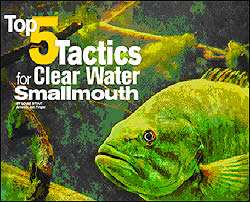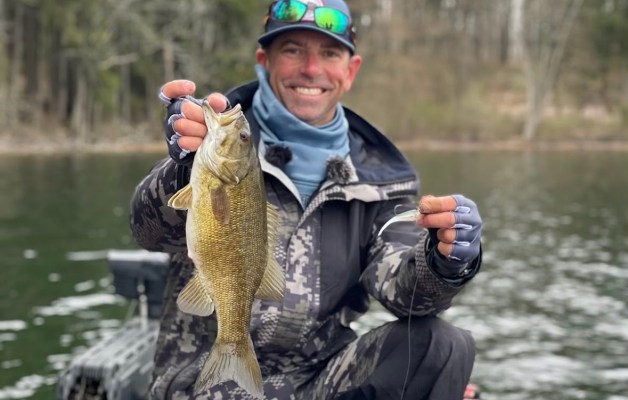
If you're a largemouth angler who comes unglued when confronted with ultraclear water, you won't like fishing for northern smallmouth — until you catch one.
Largemouth can be contrary in clear water and fishing for them can be frustrating. But smallmouth aren't as persnickety, as evidenced by the way they'll travel great distances to smash a lure during the middle of a sunny afternoon.
"The fact that smallmouth see so well in clear water can work to your advantage if you're choosing the right lures, presentations and colors," says three time Angler of the Year Kevin VanDam. "In fact, they actually can be easier to catch in clear water."
However, bass' keen eyesight requires anglers to disguise their lures, either by matching them to the correct size, color and shape of local forage or through erratic movement.
"If you can see bottom, they can probably see your lure," adds VanDam. "You want to make it look as realistic as possible.
Here are five can't-miss tactics for catching clear water smallmouth:
VanDam: Coax them with jerkbaits
1. Jerkbaits have tremendous drawing power, which is why they're one of VanDam's favorites for clear water.
"There's not another lure more efficient for covering ultraclear water quickly," he says.
When water is below 60 degrees, VanDam will rig a suspending version of Strike King's Wild Shiner. But in warmer water, he likes floating models because they impart more action.
"Floaters have more wiggle than suspending models, regardless of the brand," he explains. "And in warm water, the more erratic the action, the more excited smallmouth get."
If fishing pressure or a summertime cold front makes fish wary, VanDam adds weight to the belly of a floating jerkbait to cause it to rise slower. Sticky Weight, a tungsten-based putty, is applied between the second and third hook hanger for appropriate action.
"If you put it close to the front or add too much, it will kill the action," he notes.
Line size matters, too. When long casts are important due to water clarity, VanDam uses spinning tackle rigged with 10-pound XPS Fluorocarbon. Line heavier than 14-pound can stifle the bait's action.
Sky conditions and water clarity dictate color choices. He chooses chrome and gold on bright days, translucent or natural forage colors when it's sunny with no wind; and solid colors (whites, chartreuse) when it's cloudy or windy.
Kim Stricker: Be a "stud"
2. Tubes and jerkbaits have earned Michigan pro Kim Stricker the reputation as king of Lake St. Clair smallmouth. In recent years, the Michigan pro has been a superstud, too – as in Gambler's 5-inch "Super Stud" soft jerkbait.
"Kevin is right — there isn't a better bait for pulling smallmouth from long distances than a jerkbait," he notes. "But sometimes smallies want a more subtle presentation. That's when the Super Stud comes into play."
It's a lure he'll use in the middle of the day when bass are cruising flats in water less than 10 feet deep. He imparts short twitches with the rod to make the bait dart from side to side, and then pauses. After the bait sinks a foot or two, he resumes the twitching rhythm.
"Most of the time the fish will crush it," he explains. "But sometimes they'll just follow curiously, and that's when you want to allow it to sink deeper."
He rigs the Super Stud with a 3/0 wide gap Gamakatsu Superline hook, a heavy hook that helps the bait sink and keeps the lure falling horizontally. He fishes it on 17-pound fluorocarbon.
During summer months, smallmouth prefer a more erratic action, which can be enhanced by altering the rigging method.
Most soft jerkbaits are rigged Tex-posed, meaning the hook comes out the center of the back and the barb is pierced just beneath the plastic to keep it weedless. To create a wilder side-to-side action, Stricker points the barb off-center, which causes the Stud to dart farther.
Many anglers use a swivel on the line to reduce line twist, a common problem with soft jerkbaits. Stricker doesn't, saying it puts too much weight near the nose and alters the horizontal fall.
"If my line begins to twist, I'll point the Tex-posed hook off-center to the other side, and that relieves the twisting," he offers.
Terry Baksay: Get gaudy with spinnerbaits
3. Nothing draws ferocious strikes from clear water smallmouth like a spinnerbait cranked near the surface.
"Even in deep water," insists Connecticut pro Terry Baksay. "I've had fish come from 20 feet of water to eat a spinnerbait. But for that to happen, the fish have to see it."
That's why anglers need to add color as well as flash, since bright colors are easier for the fish to see from long distances. Chartreuse is the hands-down favorite, but Baksay often shows them something different.
"If the fish are seeing a lot of chartreuse spinnerbaits, I'll show them 'pinkie,' " he remarks. "I got on the pink-colored spinnerbait for largemouth a few years ago, and I've discovered it works remarkably well on smallmouth, too."
His 'pinkie' is a 1/2-ounce War Eagle spinnerbait with gold/silver willowleaf blades. He has found it to be more effective during bright, midday hours.
"I have no idea what it looks like to the fish, and it probably doesn't matter except they can see it moving near the surface and they clobber it," adds Baksay. "I've had them hit it before it hits the water on the initial cast."
When fishing for smallmouth, Baksay will add a No. 2 Daiichi Bleeding Bait treble hook as a trailer. Smallmouth are notorious for slapping at a spinnerbait, and the treble hook ensures more hookups.
Joe Balog: Get snappy with tubes
4. If smallmouth become lazy during the summer, you have to provoke them to strike. Ohioan Joe Balog says there's nothing like ripping a tube off the bottom to activate a school. It's a technique he's used to catch hundreds of Lake Erie bass and should work wherever smallmouth live in deep, clear water.
"It is best when the lake is calm and the fish are suspended off the bottom," he explains. "Once you trigger that first reaction strike, the rest of the school goes nuts."
After the cast, Balog jerks the tube 4 to 8 feet off the bottom and lets it fall back again. Most of the strikes occur after it begins to fall. Some strikes you won't feel, or when you jerk again, the bass already has its mouth around it.
"I think they'll follow it down, and when you jerk it, they react," he explains.
Balog uses an ISG Dream Tube he designed for Great Lakes fishing. He says it's bigger and bulkier than most, which makes it easier for fish to see and accommodates heavier jig heads. His favorite is a 1/2-ounce leadhead that is inserted into the cavity.
"Weight is important, because you want to make that tube fall quickly," he offers. "I use baitfish colors with gold or silver flake most of the time."
He snaps the tubes on 10-pound fluorocarbon line and a 7-foot medium heavy spinning rod to help drive the hook faster on deeper fish. The longer rod takes up slack faster than a shorter rod, he adds.
Danny Correia: Be a jerk with tubes
5. When smallmouth move to shallow flats, Massachusetts pro Danny Correia Texas rigs a tube and works it like a jerkbait. It's a technique he uses when trying to cover a lot of water in search of bass scattered over rocky bottoms.
"I use this during the prespawn and postspawn periods, when the fish are roaming around the flats," he describes.
Correia makes long casts and begins a jerking action with the rod tip in the same manner that most anglers fish jerkbaits.
"The faster you fish it, the more aggressive the strikes," he offers. "I don't believe you can ever fish something too fast for smallmouth."
By moving the bait rapidly and erratically, the bass never get a close look at it and it resembles crawfish or baitfish trying to get away.
"Hard-bodied jerkbaits would catch them, too, but they hang up in grass and rocks more," he explains. "The key is to keep the tube moving and bouncing erratically away from the rocks. Speed of the lure depends upon water depth; if it's 3- or 4-feet deep, I'll jerk it faster than I do in shallower water."
He rigs a Luck-E-Strike tube with a 1/8- or 1/16-ounce slip sinker, pegs it to the tube and skin hooks a 2/0 or 3/0 hook into the lure body. Not only does the Texas rig keep the bait weedless, but it deflects off rocks and adds to the erratic action.
Find the bait
A smile spread over Joe Balog's face as he pitched a marker buoy over 45 feet of water.
"This is what we're looking for," the Ohio bass pro said as he pointed to big globs of baitfish hovering off Lake Erie's rocky bottom.
"But are you sure bass are there?" I quizzed, noting there were no big arches on the LCD screen or black marks clinging to the tops of the rocks.
"Find the bait and the smallmouth are there," Balog insisted.
He was right. Our first two casts produced smallies.
Balog knows these things. Not only is he one of the most respected Lake Erie anglers, but he has a degree in fisheries management from Michigan State University.
Anglers get hung up on magic lures and honey holes rather than considering a bass' needs, the young pro offers.
"Bass – especially smallmouth – are regulated by three variables – food, spawning and fishing pressure," he explains. "On the Great Lakes, fishing pressure isn't that much of an issue, and this time of year (late summer) most of them are done spawning. That leaves the forage as the main ingredient to finding bass."
Smallmouth in Erie's eastern basin roam deep water because that's where most forage lives. Although bass feed on gobies in shallower water, shad, shiners and smelt are more readily available in deeper water. It's like a never-ending smorgasbord of fins.
"The forage moves around and the smallmouth follow them," he notes. "You can go to where you caught them on every cast yesterday, and not get a bite. But you could move to another reef or structure and kill them."
The eastern basin is filled with humps, points and rock reefs in 20 to 50 feet that attract the bait and the bass.
"But if the bait isn't showing up on the graph, you're probably wasting your time," he says.
Use fluorocarbon
Nearly all of our clear water smallmouth experts recommend fluorocarbon line. It's not only less visible to the fish, but it sinks faster and is more abrasion resistant, the latter of which is important when zebra mussels are present.
"Because fluorocarbon is less visible, I can get away with using heavier line," says Michigan pro Kevin VanDam. "It also offers less stretch, so I get better hook sets on long casts. With monofilament, stretch limits your hook setting capability."





